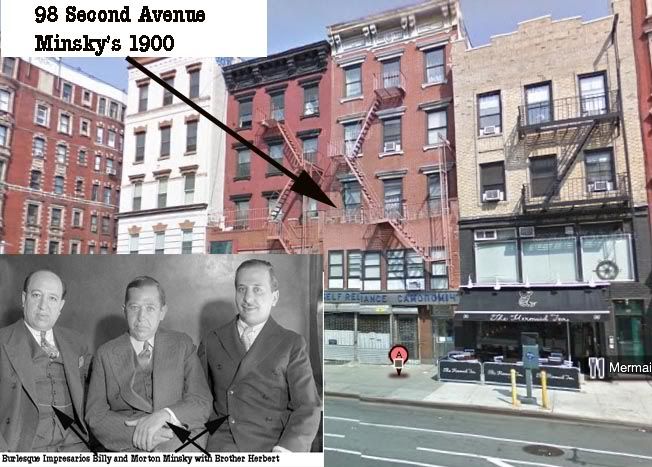Minsky's Burlesque refers to the brand of burlesque presented by the four Minsky brothers: Abe Minsky (1878–1960); Billy Minsky (1887–1932); Herbert Minsky (1892-?); and Morton Minsky (1902–1987).They started in 1912 and ended in 1937 in New York City. Although the shows were declared obscene and outlawed, they were rather tame by modern standards.
The eldest brother, Abe, launched the business in 1908 with a Lower East Side nickelodeon showing racy films. His own father shut him down and bought the National Winter Garden on Houston Street, which had a theater inconveniently located on the sixth floor. He gave the theater to Abe and his brothers Billy and Herbert. At first they tried showing respectable films but could not compete with the large theater chains. The Minskys tried to bolster their shows by bringing in vaudeville performers, but could not afford good acts.
Then they considered burlesque. Burlesque acts were cheaper, and circuits (called "wheels") supplied a new show every week, complete with cast, costumes and scenery. There was the Columbia Wheel, the American Wheel, and the Mutual Wheel. Burlesque during this period was "clean"; a fourth wheel, the Independent, actually went bankrupt in 1916 after refusing to clean up its act. The Minskys briefly considered signing with a wheel but decided to stage their own shows because it was cheaper and Billy longed to be the next Florenz Ziegfeld.
But Minsky's clientèle of poor immigrants had not been taught to appreciate clean burlesque, and the Minskys were not about to teach them. Plus, their audience needed a compelling reason to trek up to a sixth-floor theater. Billy realized that success in burlesque depended on how the girls were featured. Abe, who had been to Paris and the Folies Bergère and Moulin Rouge, suggested importing one of their trademarks: a runway to bring the girls out into the audience. The theater was reconfigured, and the Minskys were the first to feature a runway in the United States. Billy had the sign out front changed to "Burlesque As You Like It – Not a Family Show," and the Minskys were on their way.
The Minskys were raided for the first time in 1917 when Mae Dix absent-mindedly began removing her costume before she reached the wings. When the crowd cheered, Dix returned to the stage to continue removing her clothing to wild applause. Billy ordered the "accident" repeated every night. This began an endless cycle: to keep their license, the Minskys had to keep their shows clean, but to keep drawing customers they had to be risqué. Whenever they went too far, they were raided.
Morton joined the company in 1924, after graduating from New York University, and worked at the Little Apollo Theater on 125th Street. There was a raid during the very first show. For the next four years, the theater showed a weekly profit of $20,000 after payola.
Billy's attempt, however, to present classy burlesque at the Park Theater on Columbus Circle failed miserably.
Another famous raid occurred in April, 1925, and inspired the book and film The Night They Raided Minsky's. By this time it was permissible for girls in shows staged by Ziegfeld, George White and Earl Carroll – as well as burlesque – to appear topless as long as they did not move (a similar rule in London burlesque was famously demonstrated in the film Mrs. Henderson Presents). In a show at the National Winter Garden, Madamoiselle Fifi (née Mary Dawson from Pennsylvania) stripped to the waist and then moved.
Occasionally a raid was triggered by the comedy material, but filthy comics did not last long because they were a liability to the management.
Business boomed during Prohibition and the National Winter Garden's notoriety grew. Regular patrons included John Dos Passos, Robert Benchley, George Jean Nathan, Condé Nast, and Hart Crane (see Crane's poem "National Winter Garden" in The Bridge).
Saturday, January 8, 2011
The Minsky Family
When they got rich the Minsky family moved uptown to 97th Street, near 5th Avenue.
Subscribe to:
Post Comments (Atom)



























No comments:
Post a Comment